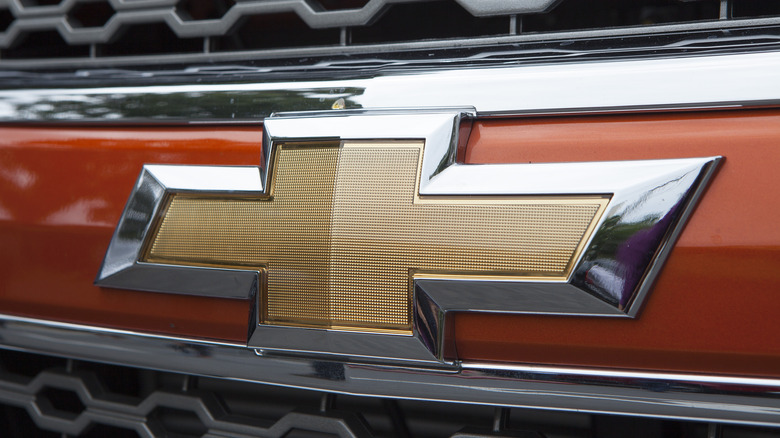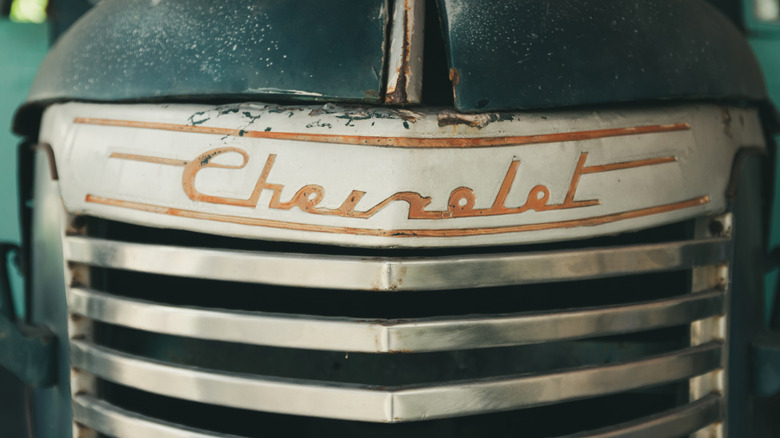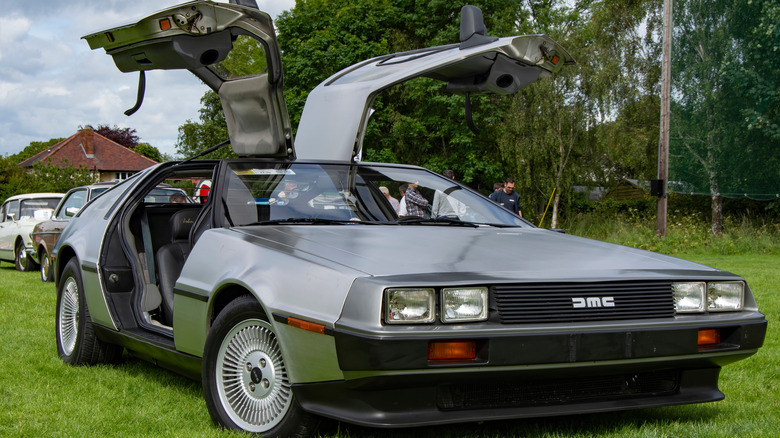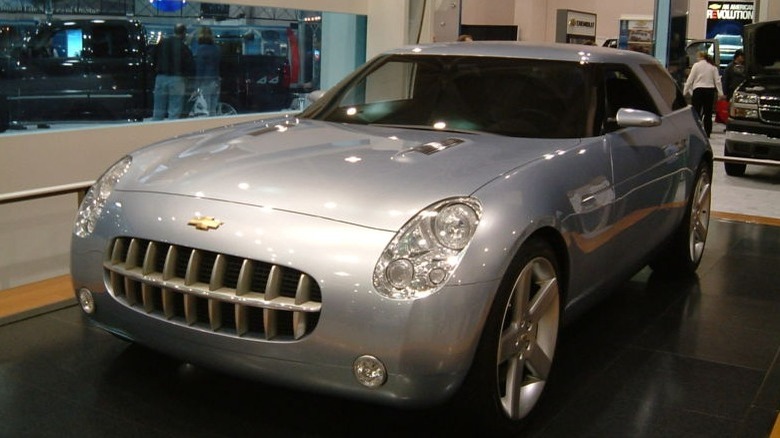

The Forgotten Chevy Nomad Concept We Wish Made It To Production
source link: https://www.slashgear.com/1119233/the-forgotten-chevy-nomad-concept-we-wish-made-it-to-production/
Go to the source link to view the article. You can view the picture content, updated content and better typesetting reading experience. If the link is broken, please click the button below to view the snapshot at that time.
The Forgotten Chevy Nomad Concept We Wish Made It To Production

Chevrolet hasn't sold a production car called the Nomad since 1980, but not for a lack of trying. Chevy has attempted to revive the Nomad at least four times, showcasing concept cars under that name in 1979, 1991, 1999, and 2004 (via Mac's Motor City Garage). The 2004 take was truly something special –- a revival of old-school American muscle a decade ahead of the curve with the space and practicality of a classic station wagon.
The factors that worked against the 2004 Nomad concept were as much economic as practical. The recession of the late 2000s had already begun to cost major manufacturers. Big ideas without immediate, demonstrable profitability tended to stay on the drawing board. Unfortunately for both GM and gearheads everywhere, the global marketplace would have to wait a few years before reintroducing new models of old-school muscle cars, rather than getting a jump on the trend with a classic American wagon.
Glory days faded

The Nomad started life as a concept car. Debuting at GM's 1954 Motorama event, the Chevy Nomad was a "dream car" meant to unite performance with day-to-day utility (via Hemmings). But then the car mysteriously disappeared after the show.
From 1955 to 1957, Chevy delivered on that aim, building a Nomad two-door wagon with room for six and a 245-hp V8, ascending to a 283-hp fuel injection model the following year (per Auto Evolution). And while the two-door model gets most of the love, the '58-'61 version was no slouch, a wagon built around the sizable skeleton and mighty V8 of the first-generation Impala.
From '61 on, the Nomad name struggled to find buyers and found itself attached to less and less impressive models. After being attached to the Chevelle, the Vega, and even the Chevy Van, the manufacturer withdrew it from American markets in 1972 (via Classic.com), building the last in South Africa in 1980.
Even before the last Nomad rolled off the line, however, Chevy was testing the waters for a comeback. In 1979, they went wildly off-book, slapping the Nomad name on a funny little people carrier that could have set off the minivan boom a few years early (via Curbside Classic). The concepts in '91 and '99 were similar: clever ideas without the design and support necessary to get off the drawing board. Then came 2004.
A not-quite-possible future
For our money, if Chevrolet could have delivered a Nomad as close to the 2004 concept as the 1955 Nomad was to the Motorama dream car, it would have been something truly special. A fast, powerful American-made muscle car that could do all the work of a minivan would have stood out proud among the new makes of classic names that were popular at the time.
The Nomad's pony car styling matched the power under the hood: The Chevy was back in the 250-hp club with a turbocharged 2.2-liter V4. Body size had shrunk since the '50s, but the Nomad still had room for six and a long vacation's worth of luggage thanks to movable seats and a lifting cargo floor (via Motor Trend).
Unfortunately, decreased spending during the Great Recession combined with tough overseas competition, and the Nomad never made it off the drawing board. We can only hope that the next concept to bear the name will be practical and exciting as its predecessor, but with slightly better luck.
10 Defunct Car Brands We Wish Still Existed

The number of automotive manufacturers that have existed since the end of the 19th century is staggering. Reasons as diverse as economic depression and recession, mismanagement, changing trends, and outright fraud have brought down many storied — as well as obscure — marques. Indeed, the annals of auto history are fraught with tales of the destruction and demise of much-loved automobiles.
Occasionally once-dead automakers achieve success through revitalization, such as Bugatti and Spyker. Others have seen attempts to restore former glory crash and burn into notorious failure. The Stutz brand is one that saw this sort of successful resurgence only to die — followed by another attempted resuscitation just to, as outlined by Forbes, once again be lost and possibly gone forever.
Despite these successes and failures, it is often an interesting and even slightly emotional exercise to ponder a future where these manufacturers did not succumb to the pressures of the marketplace and lived to see another race day in the modern era. These 10 marques deserve a second act in the 21st century.
1. American Motors Corporation
Always the underdog of the American auto landscape, AMC was an inventive manufacturer that produced many fan favorites. With such powerhouses as the Marlin and AMX, as well as the trusty Rambler and Eagle, AMC excelled in finding an unserved niche and filling it with a model unlike any other. If it had continued to survive despite its underdog position, there is no doubt modern AMC vehicles would still be cut from a different cloth.
While it would have to produce SUVs out of competitive necessity, the brand likely would have maintained its lineup of fun compact cars and wagons that most American manufacturers are abandoning. Adding to that, a modern version of the AMX could give the C8 corvette some real American competition. AMC was always the little car maker that could, and it would be fun to see what they could have done with the amazing engineering and technology of the 21st century.
2. Studebaker Corporation
Another underdog of American manufacturers, Studebaker is known for having produced well-built and interesting cars and trucks that stood out amongst the burgeoning American auto industry of the late 1800s. As noted by the Smithsonian Libraries, Studebaker began as a builder of horse-drawn carriages and would be the oldest automaker if it still existed today. While not known as a performance car manufacturer, it did make some impressive V8 engines, including some with a supercharger.
One such model that would be a fascinating modern car is the Hawk. This was their luxury coupe that paired V8 power with stunning good looks and comfort. Today it would very likely have a downsized engine powered up with turbo and/or supercharging. According to the Smithsonian Institution, Studebaker also bought the Paxton Corporation, a maker of superchargers. It would be easy to see that relationship leading to modern supercharged rockets taking advantage of advances in engineering and forced induction coming from the South Bend, Indiana automaker. Studebaker could be a fierce competitor to Buick or Volvo, slated in the upscale, yet not-quite-luxury market.
3. Duesenberg Motors Company
Sitting comfortably atop the hierarchy of luxury automakers in the early 20th century, Duesenberg was known for producing the finest automobiles in the world for the most discerning and demanding of customers. Being an extremely expensive car, it was the automobile of choice for the wealthy from actors to gangsters, per Discovery UK. Not only was Duesenberg known for opulence, but it also delivered superb engineering, developing some of the most powerful production engines of the pre-war era.
If it had survived the Depression, Duesenberg would still be a rival to Rolls-Royce and Bentley, delivering a car for the rich and famous that would fly past our current luxury marques, Lincoln and Cadillac, by leaps and bounds. No shortage of automatic and hands-free accessories or turbo power would befall a modern Duesenberg. These days, the brand would still be the standard of American luxury to which all other automakers would aspire, just the way brands did back in its heyday.
4. Pontiac
While the keeping of so many brands within General Motors may have seemed redundant, Pontiac offered unique, fun, and sporty alternatives for decades. While legitimate arguments exist for why it went under, Pontiac more often than not lived up to their motto of "We Build Excitement." One of the defining features of the brand was its inclusion of sporty cars that were attractive and fun to drive, yet not overpriced.
They often were a little more refined than their Chevrolet counterparts and offered more options to create unique models. Certainly, a modern Pontiac would include the legendary Trans-Am based on the current Camaro, but it could easily pick up the reins of the Fiero with a fun two-seater electric sports car. With Chevy and Buick mostly churning out variations of the same two-box SUV, Pontiac would be well suited for creating a niche performance brand within the General Motors family of automobiles. It may well be time to bring all that "excitement" back to the mainstream.
5. Tucker Corporation
It takes a true visionary to take on established and entrenched industrial organizations and attempt to outfox them at their own game. This has been true with Tesla as Elon Musk reframed the orthodox thinking about what a car should be and do and turned it on its head. If Tucker had Musk-level cash to finance his vision, that may not be the case.
Preston Tucker wanted to bring to market a car that excelled in all the areas in which the big three and others didn't just fail, they failed to even see there was a failure taking place. Smithsonian Magazine details the litany of safety features he wanted, including mind-blowing innovations such as seatbelts, padded dashboards, and windows that popped out in the event of a crash in an era long before safety was incorporated into auto designs.
Tucker, the man and the company, were both reduced to nothing by a bogus SEC investigation and sensational reporting, as recounted by Wired Magazine. If not for these unfortunate events, we may well have the safest electric car on the American roads wearing a Tucker badge instead of Tesla. The ideas Tucker wanted to implement were ahead of their time and a modern Tucker would surely be at the cutting edge of auto development if it only could have survived.
6. DeLorean Motor Company
With decades of experience running divisions of the largest car company on Earth, John DeLorean brought plenty of tried and true ideas to his company. However, good ideas don't necessarily make for a good company. Nonetheless, the DMC-12 automobile he created has left a lasting impression in popular culture and continues to be a fixture in the folklore of the American car enthusiast.
At the time of its release, the DMC-12 was a car that sought a very niche audience. The number of people who can afford to purchase a high-end, two-seat sports car with virtually no practicality is sparse. This has always been true, but the current market seems to have plenty of room for high-end automakers with foolishly impractical yet absurdly powerful speed machines. A modern stainless steel gullwing sports car could have a place in today's market.
The modern DeLorean would surely be electric, but had it been revived sometime in the early 2000s before the company's namesake had passed, Delorean could have easily picked up an Audi V8 in the way Spyker did or have AMG engineer a hefty turbo V6 with plenty of power. With John DeLorean's passing in 2005, his legacy shall always be sealed firmly in the past, along with a kid named Marty heading 88 mph into the future.
7. Baker Motor Vehicle Company
One of the bestsellers of the Brass Era of automobiles, which ran roughly 1896 to 1915, the Baker Motor Vehicle Company would fit nicely into the current landscape of motoring. More than a century before the emergence of Tesla as the leader in electric vehicles, Baker boasted impressive sales of up to 17 battery-powered vehicles, according to Classic, including one of the first vehicles bought for the White House fleet.
While the convenience and power of internal combustion quickly eclipsed the limitations of electric propulsion, for a time, the Baker electric car was one of America's top sellers. Car and Driver reports that in 1903, an engineer for the company managed to achieve a range of 201 miles from a single charge, albeit only while traveling 12 mph. A modern Baker Motor Vehicle Company would fit in very well into the EV revolution, wielding its authority as an original innovator in the space.
8. Jensen Motors Limited
More familiar to British audiences, Jensen's were unique, innovative, and powerful cars for the "English gentleman." From the start, Jensen was always more of a coachbuilder and produced bodies for other manufacturers in the pre-war era, notes MyAutoWorld. Some of their first original creations sat atop other manufacturers' chassis and drivetrain configurations.
Later models came about being fully manufactured by Jensen, but still using other companies' engines. One of its most loved models was the Interceptor, which was powered by a massive Chrysler Hemi V8. Australian Jensen Club Magazine states that the Jensen Interceptor FF was the first all-wheel-drive production sports car in 1966. Being a small independent company meant that they had to pool their resources with others, and when they did, created some phenomenal machines.
Should Jensen Motors exist today, it is possible they would be a clever and niche brand utilizing the vast development capabilities of Ford or VW to build fast and fun cars that are generally unattainable for most people, but not exclusively affordable to the ultra-wealthy. Even a modern proper British sports car powered by a Hellcat V8 would be an interesting proposition.
9. Saab Automobile AB
Among the quirkiest of automotive brands, Saab cranked out unique cars using meager budgets paired with ingenious Swedish engineering solutions. Among the many quirks of a Saab are the location of the key in the center of the console between the front seats, and the placement of their slanted 4 cylinder engine in reverse, such that the clutch is actually in the front of the car and the driven accessories are toward the back of the engine compartment against the firewall.
Saab fell victim to the financial crisis of 2008 during the restructuring of General Motors, which decided to sell the brand off to the highest bidder, as reported by The New York Times. The attempt by boutique car maker Spyker to keep the storied Swedish marque afloat ended in abysmal failure, with the pieces of Saab picked up by a Chinese company that, according to Motor Trend, has since gone bankrupt and later been revived as an electric mobility company. At the time of its demise, Saab had concept cars and new platforms in the works and had just released an all-new Saab 9-5 model. The Spyker-led company managed to produce only 3,419 of the new 9-5 models before production ceased, per eSaabparts.com.
It is likely a modern Saab would have continued on this path, creating new hybrid and electric models with updated styling. Without the calamity that was the 2008 financial crisis, there is no reason to think that Saab would not be here today.
10. Trabant
Of all the cars one would want to see revived, a terrible, smoky, unreliable rattlebox from East Germany is not likely to be on the list. One might question the sanity of reviving such a brand, but there are at least a few reasons to substantiate. For the uninitiated, the Trabant was a compact car produced in communist East Germany from 1957 to 1990 (production continued after German reunification, but ended in 1991). It was a small, poorly built little car with no power windows, no power seats, and generally no power at all. It was propelled by a 2-stroke, 2-cylinder air-cooled engine producing 26 horsepower coupled to a four-speed column shift transmission.
By all accounts, it was not a good car, an objective fact attested to by Motor1. But for lucky and loyal socialist party members of the DDR, or East Germany, it was a treasure. It is no surprise with the fall of the Berlin Wall that the inefficient and outdated Trabant would cease production. But with the modern automotive industry offering few, if any, truly small and affordable cars, Trabant could fit into its own low-end niche.
The thought of young professionals and college students tooling around in a modern Trabant complete with all of its original styling is not so far-fetched. If vinyl records can once again dominate the sales charts, there's no reason Trabant couldn't, too.
Recommend
About Joyk
Aggregate valuable and interesting links.
Joyk means Joy of geeK
